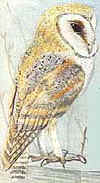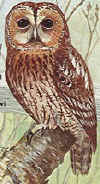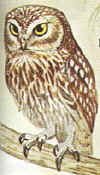|
|

|
Barn
Owl - Tyto
alba
This
owl is becoming scarcer as farming techniques change and the large
trees and old barns in which it nests disappear. It is perhaps best
known for its long eerie screech and thundering hunting call and its
most usually seen at dusk when it appears to seek voles, rats and,
occasionally, small birds for food. In the dull light it appears as
a ghostly snow-white bird with a furry round head and black eyes in
a white face; in the full light - and in some areas it also hunts by
day - it can be seen that only the underpants are pure white, the
upper parts being mottled from faintest orange to burnished
brown-copper, shading to purplish-grey.
Size:
Large - 34cm. |
|
Tawny
Owl - Strix
aluco
This
is the most widely distributed of all British owls, although absent
from Ireland, and is found in many habitats from large towns with
hollow trees in parks and gardens to the far cold regions of north
of Scotland.
It
is identified by its quavering hooting and staccato kee-veck hunting
note as it rarely begins to hunt before nightfall. Occasionally it
may be seen out during the day from the tree where it is roosting by
a small population of birds. It can be recognised by its dark,
heavily built form with a very large round head, a spotted and
streaked brown to greyish body, and broad rounded wings which it
flaps methodically in slow beats.
Size:
Large - 38cm |
 |
|
 |
Little
Owl - Athene
noctua
It
was first introduced in the Midlands from the Continent in 1889.
This small spotted creamy-white and greyish-brown owl, has spread to
farmland, sand dunes and other areas like forests or pastures in
England, Wales and the Scottish Borders.
It
is often seen during the day bobbing and bowing on the ground or a
perch on a tree in its habitat with fiery, starry yellow eyes and
white feathers surrounding the eye area.
Size:
Medium - 21cm. |
Owl
Boxes Introduction
'Nest'
is not really the appropriate word to use in relation to Barn Owls, since
they build no nest as such, but lay their eggs on a layer of pellets which
has accumulated in their roosting site. Such sites are deep spacious
cavities in trees (especially Elms), dark corners of barns, churches, and
old buildings, or even gaps in straw stacks. With the loss of so many elms
in recent years through disease, and so many old buildings through
modernisation, nest boxes provide a real opportunity for this declining
species to re-establish its population. Owls may accept a nest box
readily, but use it only for roosting for as long as two years before
finally breeding.
|
There
is no real design for a Barn Owl nest box - any large box is
acceptable if it is at least 18 x 18 x 24 inches. For internal use
(barns and old buildings) the traditional tea chest can be ideally
adapted; but for external use, good quality, heavy, waterproof board
must be used.
|
 |
| You
can get an idea of what one looks like by the picture opposite. The ideal
site for a box is a dark corner on a beam in an undisturbed building
near farmland, away from busy roads, and where there is permanent
access for the owls through doors, windows or other such holes. An
entrance hole 9 x 9 inches should be cut from one of the bottom corners,
and a lipped tray fitted in front of the entrance to provide an exercise
area for the young owls. It
is also possible to site boxes in modern, prefabricated farm buildings,
using battens, bolts and wire, but the need for a permanent means of
access to the building for the owls is vital. |
Top
of Page
|

